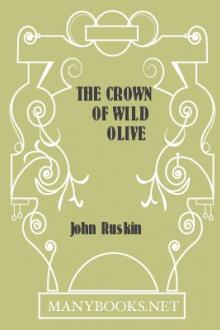The Crown of Wild Olive, John Ruskin [best ereader for graphic novels .txt] 📗

- Author: John Ruskin
- Performer: -
Book online «The Crown of Wild Olive, John Ruskin [best ereader for graphic novels .txt] 📗». Author John Ruskin
Use Chinese white, well ground, to mix with your colours in order to pale them, instead of a quantity of water. You will thus be able to shape your masses more quietly, and play the colours about with more ease; they will not damp your paper so much, and you will be able to go on continually, and lay forms of passing cloud and other fugitive or delicately shaped lights, otherwise unattainable except by time.
This mixing of white with the pigments, so as to render them opaque, constitutes body-colour drawing as opposed to transparent-colour drawing and you will, perhaps, have it often said to you that this body-colour is "illegitimate." It is just as legitimate as oil-painting, being, so far as handling is concerned, the same process, only without its uncleanliness, its unwholesomeness, or its inconvenience; for oil will not dry quickly, nor carry safely, nor give the same effects of atmosphere without tenfold labour. And if you hear it said that the body-colour looks chalky or opaque, and, as is very likely, think so yourself, be yet assured of this, that though certain effects of glow and transparencies of gloom are not to be reached without transparent colour, those glows and glooms are not the noblest aim of art. After many years' study of the various results of fresco and oil painting in Italy, and of body-colour and transparent colour in England, I am now entirely convinced that the greatest things that are to be done in art must be done in dead colour. The habit of depending on varnish or on lucid tints transparency, makes the painter comparatively lose sight of the nobler translucence which is obtained by breaking various colours amidst each other: and even when, as by Correggio, exquisite play of hue is joined with exquisite transparency, the delight in the depth almost always leads the painter into mean and false chiaroscuro; it leads him to like dark backgrounds instead of luminous ones,[235] and to enjoy, in general, quality of colour more than grandeur of composition, and confined light rather than open sunshine: so that the really greatest thoughts of the greatest men have always, so far as I remember, been reached in dead colour, and the noblest oil pictures of Tintoret and Veronese are those which are likest frescos.
Besides all this, the fact is, that though sometimes a little chalky and coarse-looking, body-colour is, in a sketch, infinitely liker nature than transparent colour: the bloom and mist of distance are accurately and instantly represented by the film of opaque blue (quite accurately, I think, by nothing else); and for ground, rocks, and buildings, the earthy and solid surface is, of course, always truer than the most finished and carefully wrought work in transparent tints can ever be.
Against one thing, however, I must steadily caution you. All kinds of colour are equally illegitimate, if you think they will allow you to alter at your pleasure, or blunder at your ease. There is no vehicle or method of colour which admits of alteration or repentance; you must be right at once, or never; and you might as well hope to catch a rifle bullet in your hand, and put it straight, when it was going wrong, as to recover a tint once spoiled. The secret of all good colour in oil, water, or anything else, lies primarily in that sentence spoken to me by Mulready: "Know what you have to do." The process may be a long one, perhaps: you may have to ground with one colour; to touch it with fragments of a second; to crumble a third into the interstices; a fourth into the interstices of the third; to glaze the whole with a fifth; and to reinforce in points with a sixth: but whether you have one, or ten, or twenty processes to go through, you must go straight through them, knowingly and foreseeingly all the way; and if you get the thing once wrong, there is no hope for you but in washing or scraping boldly down to the white ground, and beginning again.
The drawing in body-colour will tend to teach you all this, more than any other method, and above all it will prevent you from falling into the pestilent habit of sponging to get texture; a trick which has nearly ruined our modern water-colour school of art. There are sometimes places in which a skilful artist will roughen his paper a little to get certain conditions of dusty colour with more ease than he could otherwise; and sometimes a skilfully rased piece of paper will, in the midst of transparent tints, answer nearly the purpose of chalky body-colour in representing the surfaces of rocks or buildings. But artifices of this kind are always treacherous in a tyro's hands, tempting him to trust in them; and you had better always work on white or grey paper as smooth as silk;[236] and never disturb the surface of your colour or paper, except finally to scratch out the very highest lights if you are using transparent colours.
I have said above that body-colour drawing will teach you the use of colour better than working with merely transparent tints; but this is not because the process is an easier one, but because it is a more complete one, and also because it involves some working with transparent tints in the best way. You are not to think that because you use body-colour you may make any kind of mess that you like, and yet get out of it. But you are to avail yourself of the characters of your material, which enable you most nearly to imitate the processes of Nature. Thus, suppose you have a red rocky cliff to sketch, with blue clouds floating over it. You paint your cliff first firmly, then take your blue, mixing it to such a tint (and here is a great part of the skill needed), that when it is laid over the red, in the thickness required for the effect of the mist, the warm rock-colour showing through the blue cloud-colour, may bring it to exactly the hue you want; (your upper tint, therefore, must be mixed colder than you want it;) then you lay it on, varying it as you strike it, getting the forms of the mist at once, and, if it be rightly done, with exquisite quality of colour, from the warm tint's showing through and between the particles of the other. When it is dry, you may add a little colour to retouch the edges where they want shape, or heighten the lights where they want roundness, or put another tone over the whole; but you can take none away. If you touch or disturb the surface, or by any untoward accident mix the under and upper colours together, all is lost irrecoverably. Begin your drawing from the ground again if you like, or throw it into the fire if you like. But do not waste time in trying to mend it.[237]
This discussion of the relative merits of transparent and opaque colour has, however, led us a little beyond the point where we should have begun; we must go back to our palette, if you please. Get a cake of each of the hard colours named in the note below[238] and try experiments on their simple combinations, by mixing each colour with every other. If you like to do it in an orderly way, you may prepare a squared piece of pasteboard, and put the pure colours in columns at the top and side; the mixed tints being given at the intersections, thus (the letters standing for colours):
This will give you some general notion of the characters of mixed tints of two colours only, and it is better in practice to confine yourself as much as possible to these, and to get more complicated colours, either by putting a third over the first blended tint, or by putting the third into its interstices. Nothing but watchful practice will teach you the effects that colours have on each other when thus put over, or beside, each other.
When you have got a little used to the principal combinations, place yourself at a window which the sun does not shine in at, commanding some simple piece of landscape; outline this landscape roughly; then take a piece of white cardboard, cut out a hole in it about the size of a large pea; and supposing R is the room, a d the window, and you are sitting at a, Fig. 29., hold this cardboard a little outside of the window, upright, and in the direction b d, parallel a little turned to the side of the window, or so as to catch more light, as at a d, never turned as at c d, or the paper will be dark. Then you will see the landscape, bit by bit, through the circular hole. Match the colours of each important bit as nearly as you can, mixing your tints with white, beside the aperture. When matched, put a touch of the same tint at the top of your paper, writing under it: "dark tree colour," "hill colour," "field colour," as the case may be. Then wash the tint away from beside the opening, and the cardboard will be ready to match another piece of the landscape.[239] When you have got the colours of the principal masses thus indicated, lay on a piece of each in your sketch in its right place, and then proceed to complete the sketch in harmony with them, by your eye.
In the course of your early experiments, you will be much struck by two things: the first, the inimitable brilliancy of light in sky and in sunlighted things: and the second, that among the tints which you can imitate, those which you thought the darkest will continually turn out to be in reality the lightest. Darkness of objects is estimated by us, under ordinary circumstances, much more by knowledge than by sight; thus, a cedar or Scotch fir, at 200 yards off, will be thought of darker green than an elm or oak near us; because we know by experience that the peculiar colour they exhibit, at that distance, is the sign of darkness of foliage. But when we





Comments (0)